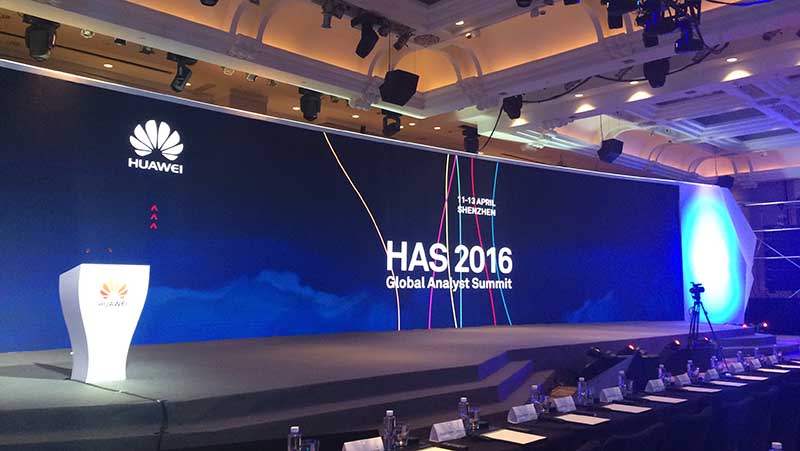How CloudRAN could solve the UK’s mobile coverage problem
Huawei talks up new radio access network product as crucial to 5G future


Chinese tech giant Huawei has suggested its latest radio access network, CloudRAN, could help solve some of the UK's mobile coverage issues and suggested it is a key component for the success of global 5G roll-out.
Cloud RAN, also known as C-RAN, is a multi-band radio access network (RAN) technology that aims to deliver many different types of signal, be that WiFi, 3G, 4G, or 5G, through a single cloud-based, distributed architecture.
This centralises the electronics of multiple cell units, whether they are macrocells (base stations), microcells or picocells, into a single location the base station server which uses a virtualised OS to prioritise workloads both on the fly and to a predetermined schedule based on predicted needs and real-time needs.
This means that, in theory, whichever is the better signal available in any given area will be the one delivered to a smartphone within range.
Speaking at a media roundtable hosted at the annual Huawei Analyst Conference in Shenzhen, China, Yang Chaobin, CMO of the company's wireless network product line and one of the pioneers in developing Huawei's RAN technologies, said: "For the coverage issue [in the UK], in an area if an end user wants to enjoy mobile communication services, the most important condition is the smartphone can receive a signal. If in one area the user cannot receive any signal at all then I don't think any solution can help solve that problem!
"[But] the CloudRAN solution can provide [better] performance when a user is in an overlapping or edge area of multiple cells and all those cells provide a weak signal. By using CloudRAN, we can provide a better experience for the end user."
Yang added that, more broadly, Cloud RAN technology in general and Huawei's own CloudRAN product specifically, will be vital to the successful roll-out of 5G around the world.
Sign up today and you will receive a free copy of our Future Focus 2025 report - the leading guidance on AI, cybersecurity and other IT challenges as per 700+ senior executives
If network providers intend to rely solely on 5G for connectivity, he said, then it will not work. The mobile network architecture needs to be modernised with C-RAN before the commercial roll-out of the technology takes place, which Huawei expects to take place by 2020, in order to provide a smooth transition and better experience for users onto new mobile connectivity technologies, from 5G and beyond.

Jane McCallion is Managing Editor of ITPro and ChannelPro, specializing in data centers, enterprise IT infrastructure, and cybersecurity. Before becoming Managing Editor, she held the role of Deputy Editor and, prior to that, Features Editor, managing a pool of freelance and internal writers, while continuing to specialize in enterprise IT infrastructure, and business strategy.
Prior to joining ITPro, Jane was a freelance business journalist writing as both Jane McCallion and Jane Bordenave for titles such as European CEO, World Finance, and Business Excellence Magazine.
-
 Trump's AI executive order could leave US in a 'regulatory vacuum'
Trump's AI executive order could leave US in a 'regulatory vacuum'News Citing a "patchwork of 50 different regulatory regimes" and "ideological bias", President Trump wants rules to be set at a federal level
-
 TPUs: Google's home advantage
TPUs: Google's home advantageITPro Podcast How does TPU v7 stack up against Nvidia's latest chips – and can Google scale AI using only its own supply?
-
 Huawei executive says 'we need to embrace AI hallucinations’
Huawei executive says 'we need to embrace AI hallucinations’News Tao Jingwen, director of Huawei’s quality, business process & IT management department, said firms should embrace hallucinations as part and parcel of generative AI.
-
 Application enablement in an AI world
Application enablement in an AI worldHow enterprises can tap into AI-fueled application enablement to build apps faster and deploy them while consuming fewer resources
-
 6G: Pioneering a new era of innovation and business value
6G: Pioneering a new era of innovation and business valueSponsored Content Discover how 6G will redefine the wireless industry through innovation, AI integration, and groundbreaking technology to drive new business value
-
 Huawei at Gitex Global 2024: driving innovation in industrial digitalization and intelligent transformation
Huawei at Gitex Global 2024: driving innovation in industrial digitalization and intelligent transformationSponsored Content Huawei showcased its latest advancements at Gitex Global 2024, focusing on accelerating digital transformation through innovative product launches, partnerships, and AI-ready ICT infrastructure
-
 Huawei Cloud: enabling business and industry growth
Huawei Cloud: enabling business and industry growthSponsored Content Huawei Cloud is transforming industries with innovative cloud, AI, and digital solutions, empowering enterprises to achieve growth and success in the digital age
-
 Amplifying intelligence: Huawei’s smart solutions for manufacturing and large enterprises
Amplifying intelligence: Huawei’s smart solutions for manufacturing and large enterprisesSponsored Content As industries face mounting pressures to innovate, Huawei is launching ten new intelligent solutions, designed to transform manufacturing, retail, and real estate through cutting-edge ICT represented by AI and cloud technologies
-
 How the media industry can take advantage of the AI wave
How the media industry can take advantage of the AI waveSponsored Content Welcome to a new way to create and consume movies, animation, and even the morning news
-
 Huawei AI tech used to filter out invasive salmon species in Norway river trial
Huawei AI tech used to filter out invasive salmon species in Norway river trialNews Pacific salmon threaten to overwhelm Atlantic salmon in hundreds of rivers along the nation’s coastline